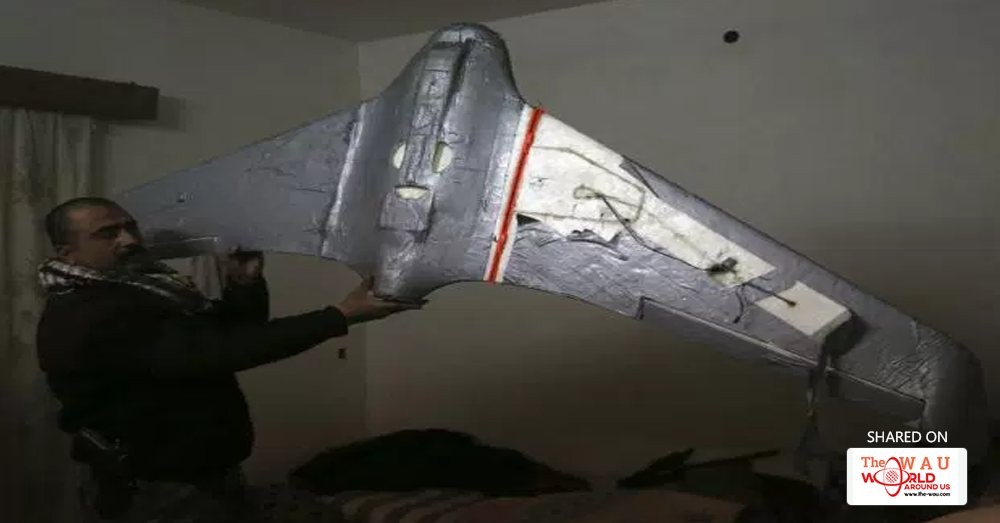Late last month, a pair of ISIL fighters in desert camouflage climbed to the top of a river bluff in northern Iraq to demonstrate an important new weapon: a small drone, about six feet wide with swept wings and a small bomb tucked in its fuselage.
The two men launched the slender machine and took videos from a second, smaller drone that shadowed its movements. The aircraft glided over the besieged city of Mosul, swooped close to an Iraqi army outpost and dropped its bomb, scattering Iraqi troops with a small blast that left one figure sprawled on the ground, apparently dead or wounded.
The incident was among dozens in recent weeks in a rapidly accelerating campaign of armed drone strikes by the Islamic State of Iraq and the Levant in northern Iraq. The terrorist group last month formally announced the establishment of a new “Unmanned Aircraft of the Mujahideen” unit, a fleet of modified drones equipped with bombs, and claimed that its drones had killed or wounded 39 Iraqi soldiers in a single week.
“A new source of horror for the apostates!” the group’s official al-Naba newsletter declared.

While the casualty claim is almost certainly exaggerated, U.S. officials confirm that the terrorist group appears to have crossed a threshold with its use of unmanned aircraft. Two years after ISIL first used commercially purchased drones to conduct surveillance, the militants are showing a growing ambition to use the technology to kill enemies, U.S. officials and terrorism experts say.
The threat to troops is serious enough to prompt U.S. and Iraqi commanders to issue warnings to soldiers near the front lines. But a far bigger worry, U.S. officials say, is the potential for future attacks against civilians. Islamic militants have long discussed the possibility of using drones as remote-control missiles that can deliver explosives or even unconventional weapons such as deadly nerve agents. In recent weeks, the notion of terrorist drones has moved a step closer to reality, terrorism experts say.
“They’re now showing that these devices can be effective on the battlefield,” said Steven Stalinsky, executive director of the Middle East Media Research Institute (MEMRI), a Washington nonprofit that analyzed dozens of incidents for a new report on Islamic militant groups’ use of drones. “With the way these groups use social media, my worry is that they’re also putting the idea into people’s heads that this is something you can now do.”
To be sure, the lightweight, relatively inexpensive drones in the jihadists’ fleet are nowhere close to matching the sophistication and lethal power of the Predators and Reapers used by the U.S. military. The drones displayed by ISIL are too small to carry heavy bombs and rockets, and they lack the guidance systems used by U.S. pilots to steer missiles toward their targets. Still, even a small bomb, such as the three-pound mortar shells typically used against Iraqi government troops, can have an effective blast radius of 30 to 45 feet, enough to kill or injure dozens of people if dropped in a crowded area.
Pentagon officials say the drones have scant military significance and will not affect the Iraqi government’s timetable for recapturing Mosul, the northern Iraqi city that fell to the Islamic State in 2014.
“Although dangerous, and effective as a propaganda tactic, it has limited operational effect on the battlefield and will not change the outcome,” Air Force Col. John L. Dorrian, spokesman for the U.S.-led coalition opposing ISIL, said at a press briefing last week.
The coalition takes this threat seriously
But a second Pentagon official acknowledged that coalition troops had been forced to take countermeasures against drones – steps that include early-detection systems and electronic jamming – while also stepping up the search for factories and staging areas where the aircraft are being readied for use on the battlefield.
“The coalition takes this threat seriously,” said the official, who insisted on anonymity in discussing the military’s response to the new threat.
As recently as a decade ago, drones were the province of a few advanced industrialized countries, especially the United States, the pioneer and lead practitioner in the use of unmanned aerial vehicles to target and kill suspected terrorists overseas. But today, dozens of countries, including Israel, China and Iran, manufacture and operate military-grade UAVs.
At the same time, a rapidly growing commercial drone industry has made the technology available to private consumers almost anywhere in the world. Online shoppers can pick from hundreds of models, from sparrow-sized “nano” drones that can be controlled from a smartphone to larger aircraft that cost thousands of dollars and can carry small payloads.
...[ Continue to next page ]
Share This Post















